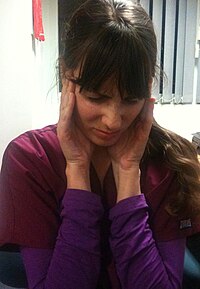
Photo from wikipedia
Background and Objectives Tension type headache is one of the costliest primary headaches which can cause a significant impact on an individual's life. Healthcare professionals are exposed to multiple trigger… Click to show full abstract
Background and Objectives Tension type headache is one of the costliest primary headaches which can cause a significant impact on an individual's life. Healthcare professionals are exposed to multiple trigger factors which give rise to an increase in headache frequency, most notable reasons being sleep disturbances, stress and untimely food habits. With this background, we conducted this study of detailed clinical profile and trigger factors among the 2050 subjects (MBBS students: 909, BDS students: 323, nursing students: 268, postgraduates students and staff: 550) in our medical institute. Materials and Methods Subjects were given questionnaires on headache and were instructed to give the details of their clinical symptoms along with relevant questions on trigger factors. The assessment tools used were the Visual Analogue Scale (VAS) and Migraine Disability Assessment Scale (MIDAS). Results Out of 2050 subjects, 464 patients suffered from tension type headache. Overall prevalence of tension type headache was 22.6%. Prevalence was higher in females (57.9%) as compared to males (42.1%). Headache experienced by majority of the student population was unilateral (31.4%), pulsating type (51.6%) and of moderate intensity (77.1%). Common associated symptoms were nausea associated with other factors (40%) and photophobia and phonophobia (18.6%). Stress (72.1%) and decreased sleep (49.4%) were the most common triggering factors. Practice of self-medication was reported by 80.2% of subjects. Conclusion Our study noted a high frequency of trigger factors in medical professionals, the most common triggering factors being stress and disturbed sleep. To our knowledge this is the first large study to evaluate headache and specifically tension type headache among medical professionals.
Journal Title: Neurology India
Year Published: 2022
Link to full text (if available)
Share on Social Media: Sign Up to like & get
recommendations!